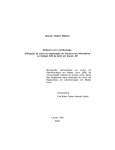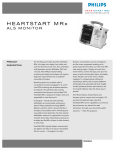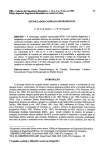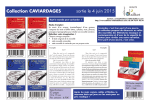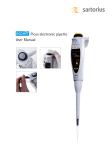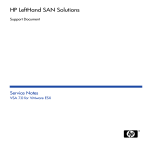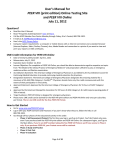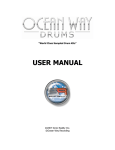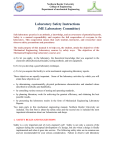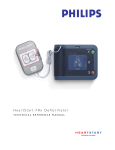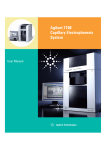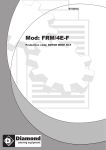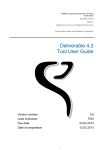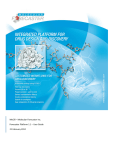Download Mechanical CPR device with variable resuscitation protocol
Transcript
USOO8795208B2 (12) United States Patent (10) Patent N0.: Walker (54) (75) (73) (45) Date of Patent: MECHANICAL CPR DEVICE WITH VARIABLE RESUSCITATION PROTOCOL Inventor: 5,716,318 A 5,722,613 A Rob Walker, Bothell, WA (US) (US) Aug. 5, 2014 2/1998 Manning 3/1998 MICha?1 5,743,864 A 4/1998 Baldwrn, 11 5,997,488 A 12/1999 Gelfand et al. 6,390,996 B1 Assignee: Physio-Control, Inc., Redmond, WA ( * ) Notice: US 8,795,208 B2 5/2002 Halperin et al‘ 6,398,745 B1 * 6/2002 6,676,613 B2 1/2004 Cantrell et al. 7,311,680 B2 12/2007 LenhaIt et al. Subject to any disclaimer, the term of this ( patent is extended or adjusted under 35 Sherman et al. .............. .. 601/41 Continued ) FOREIGN PATENT DOCUMENTS U.S.C. 154(b) by 272 days. GB (21) Appl. No.: 10/981,365 (22) Filed: 8/2008 OTHER PUBLICATIONS NOV' 3’ 2004 Prior Publication Data (65) 2446124 A Hallstrom et al., “Cardiopulmonary Resuscitation by Chest Com pression Alone or with Mouth-To-Mouth Ventilation”, May 25, 2000, The New England Journal of Medicine, vol. 342, N0. 21, pp. 1546 US 2006/0094991A1 May 4, 2006 15534 (51) Int. Cl. (Continued) A61H 31/00 (52) (58) (2006.01) us CL Primary Examiner * Quang D Thanh USPC ........................................... .. 601/41; 601/ 108 (74) Attorney, Agent, or Firm * Baker & Hostetler LLP Field of Classi?cation Search CPC A61H 31/00; A61H 31/004; A61H 31/006; (57) ABSTRACT A61H 2031/00; A61H 2031/001; A61H 2031/003; A61H 2201/1619; A61H Methods to control the delivery of CPR to a patient through a mechanical CPR device are described. The method generally 2201/5007; A61H 2203/0456; A61H 2205/08 USPC ~~~~ 601/41, 42’ 43s 44s 107: 198; 128/898 see apphcanon ?le for complete searCh hlstOI'Y_ (56) References Clted allows for a gradual increase in the frequency of CPR cycles. The gradual increase can be regulated by protocols pro grammed within the CPR device such as intermittently start ing and stopping the delivery of CPR, accelerating the deliv ery of CPR, stepping up the CPR frequency, increasing the force of CPR, and adjusting the ratio of compression and US. PATENT DOCUMENTS 4,060,079 A 4,397,306 A * 8/1983 4,424,806 A 4,570,615 A 1/1984 Newman et al. 2/1986 Barkalow 4,928,674 5,020,516 5,261,394 5,490,820 A A A A decompression in a CPR cycle. Combinations of each of these forms may also be used to control the delivery of CPR. This 11/1977 Reinhold, Jr. 5/1990 6/1991 11/1993 2/1996 manner of gradually accelerating arti?cial blood ?ow during Weisfeldt et a1. ............. .. 601/41 the ?rst minutes of mechanical CPR delivery can serve to lessen the potential for ischemia/reperfusion injury in the Halperin et al. Biondi et a1. Mulligan et a1. Schock et a1. patient who receives mechanical CPR treatment. 45 Claims, 4 Drawing Sheets 21 \ . CPR MODE 25 T ON 1 23/ 24/ ON 27 T ON 2 29 T ON 3 OFF — | T STA RT W US 8,795,208 B2 Page 2 References Cited Emergency Cardiovascular Care. Circulation. Nov. 2, 2010; 122(18 U.S. PATENT DOCUMENTS Cave DM, et al., Part 7: CPR techniques and devices: 2010 American Heart Association Guidelines for Cardiopulmonary Resuscitation (56) Suppl 3):S685-705. 7,717,855 B2 8,343,081 B2 2003/0135085 2003/0135139 2004/0230140 2005/0165335 2006/0089574 2007/0004992 A1 A1 A1 A1 A1 A1 5/2010 1/2013 7/ 2003 7/ 2003 1 1/ 2004 7/2005 4/2006 1/2007 Caldarone et al. Walker Bassuk et al. Bassuk et al. Steen Sherman et al. Paradis Van Brunt et a1. OTHER PUBLICATIONS and Emergency Cardiovascular Care. Circulation. Nov, 2, 2010; 122(18 Suppl 3):S720-8. Chapman, F.W. et al., “A Feedback Controller for Ventilatory Therapy”, Annals of Biomedical Engineering, 1985, 13, 359-372. Maquet Servo Ventilator 900 C/D/E, Service Manual, Maquet Criti cal Care AB, May 2009, 55 pages. Neumar RW, et al.,Part 8: adult advanced cardiovascular life support: 2010 American Heart Association Guidelines for Cardiopulmonary Resuscitation and Emergency Cardiovascular Care. Circulation. Nov. 2, 2010; 122(18 Suppl 3):S729-67. Kern et al., “Ef?cacy of Chest Compression-Only BLS CPR in the Presence of an Occluded Airway”, 1998, Elsevier Science Ireland Ltd., Resuscitation 39 (1998), Accpted Nov. 11, 1998, pp. 179-188.* Zhi-Qing Zhao, Joel S. Corvera, Michael E. Halkos, FaraZ Kerendi, Ning-Ping Wang, Robert A. Guyton and Jakob Vinten-Johansen, Ovize M, et al., “Working Group of Cellular Biology of Heart of European Society of Cardiology. Postconditioning and protection from reperfusion injury: where do we stand?” Position paper from the Working Group of Cellular Biology of the Heart of the European Society ofCardiology. Cardiovasc Res. Aug. 1, 2010; 87(3):406-23. Part 4: Adult Basic Life Support, Circulation, 2005, 112: IV-18 to Inhibition of myocardial injury by ischemic po stconditioning during reperfusion: comparison with ischemic preconditioning, Am J IV-34. Physiol Heart Circ Physi01285, 2003, p. H579-H588, The American Part 6: CPR Techniques and Devices, Circulation, 2005, 112: IV-47 Physiological Society. to IV-50. Michael Galagudza, Dmitry Kurapeev, Sarkis Minasian, Guro Valen, and Jarle Vaage, Ischemic postconditioning: brief ischemia during reperfusion converts persistent ventricular ?brillation into regular rhythm, European Journal of Cardio-thoracic Surgery 25 (2004), p. Segal N, et al., “Ischemic postconditioning at the initiation of cardiopulmonary resuscitation facilitates functional cardiac and cerebral recovery after prolonged untreated ventricular ?brillation”, 1006-1010, Elsevier B.V. Michael E. Halkos, FaraZ Kerendi, Joel S. Corvera, Ning-Ping Wang, Hajime Kin, Christopher S. Payne, He-Ying Sun, Robert A. Guyton, Jakob Vinten-Johansen, and Zhi-Qing Zhao, The Society of Thoracic Surgeons, 2004, p. 961-969, Elsevier Inc. Gerd Heusch, Postconditioning, Old Wine in a New Bottle?, Journal of the American College of Cardiology, 2004, vol. 44, No. 5, p. 1111-1112, Elsevier Inc. Resuscitation. Nov. 2012; 83(11):1397-1403. Travers AH, et al., Part 4: CPR overview: 2010 American Heart Association Guidelines for Cardiopulmonary Resuscitation and Emergency Cardiovascular Care. Circulation. Nov. 2, 2010; 122(18 Suppl 3):S676-84. Wang JY, et al., “Ischemic postconditioning protects against global cerebral ischemia/reperfusion-induced injury in rats”, Stroke. Mar. 2008; 39(3):983-90. Yannopoulos D, et al., “Controlled pauses at the initiation of sodium Hajime Kin, Zhi-Qing Zhao, He-Ying Sun, Ning-Ping Wang, Joel S. nitroprusside-enhanced cardiopulmonary resuscitation facilitate Corvera, Michael E. Halkos, FaraZ Kerendi, Robert A. Guyton, and neurological and cardiac recovery after 15 mins of untreated Jakob Vinten-Johansen, Postconditioning attenuates myocardial ischemia-reperfusion injury by inhibiting events in the early minutes ventricular ?brillation”, Crit Care Med. May 2012; 40(5):1562-9. Yannopoulos D, et al., “Ischemic post-conditioning and vasodilator therapy during standard cardiopulmonary resuscitation to reduce cardiac and brain injury after prolonged untreated ventricular ?bril lation”, Resuscitation. Aug. 2013; 84(8): 1143-9. Epub Jan. 29, 2013. Zhao, Heng, “The Protective Effects of Ischemic Postconditioning against Stroke: From Rapid to Delayed and Remote Postcondition of reperfusion, Cardiovascular Research 62, 2004, p. 75-85, Elsevier B.V. Andrew Tsang, Derek J. Housenloy, Mihaela M. Mocanu, and Derek M. Yellon, Postconditioning: A Form of “Modi?ed Reperfusion” Protects the Myocardium by Activating the Phosphatidylinositol 3-Kinase-Akt Pathway, Circulation Research, 2004, p. 230-232, ing”, The Open Drug Discovery Journal, 2010, 2, 138-147. American Heart Association, Inc. ZhouY, et al., “Postconditioning in cardiopulmonary resuscitation: a Xi-MingYang, J. Bradley Proctor, Thomas Kreig, James Downey and Michael V. Cohen, Multiple, Brief Coronary Occlusions During Early Reperfusion Protect Rabbit Hearts by Targeting Cell Signaling Pathways, Journal of the American College of Cardiology, 2004, vol. better protocol for cardiopulmonary resuscitation”, Med Hypoth eses. Sep. 2009; 73(3):321-3. 2009.03.014. Epub Apr. 24, 2009. 44, No. 5, p. 1103-1110, Elsevier Inc. Roberto J. DiaZ and Gregory J. Wilson, Modifying the ?rst minute of reperfusion: potential for myocardial salvage, Cardiovascular Research 62, 2004, p. 4-6, Elsevier B.V. International.Search Report and Written Opinion, PCT/US2005/ 39633, Intl. ?ling date Nov. 2, 2005. Of?ce Action dated Apr. 1, 2009 for US. Appl. No. 11/961,687 (8 The Free Dictionary, De?nition of amechanical device, p. 1 of 2, Apr. 9, 2012. Of?ce Action from US. Appl. No. 11/961,687, mailed Mar. 25, 2010, 9 pp. Of?ce Action Response for US. Appl. No. 11/961,687 ?led Jun. 25, 2010, 19 pp. U.S. Appl. No. 11/961,687: Final of?ce action dated Sep. 8, 2010, 10 pages. U.S. Appl. No. 11/961,687: Non-?nal of?ce action dated Apr. 25, pgs) 2011, 6 pages. Responsive Amendment dated Jul. 1, 2009 for US. Appl. No. U.S. Appl. No. 11/961,687: Final of?ce action datedApr. 13, 2012, 7 11/961,687 (14 pgs.). pages. Of?ce Action Response for US Appl. No. 11/961,687, ?led Jun. 25, 2010, 19 pp. Berg RA, et al., Part 5: adult basic life support: 2010 American Heart Association Guidelines for Cardiopulmonary Resuscitation and U.S. Appl. No. 11/961,687: Notice ofAllowance dated Sep. 28, 2012, 5 pages. * cited by examiner US. Patent Aug. 5, 2014 Sheet 1 0f4 US 8,795,208 B2 11 \\ A 16\ LLI DC 3 5g 10 \ LL] 2 0 LL TIME COMPRESSION ' RELAXATION 11 L PHASE u PHASE _, l‘ \ 7‘ \ 'I 14 L 15 CYCLE I‘ ' _, \ VI 13 FIG. 1 21\ CPR MODE 25 T ON 1 27\ T ON 2 29\v T ON 3 V US. Patent Aug. 5,2014 3Q. a; Sheet 2 0f4 US 8,795,208 B2 35\ 34 /30 5 § 33 E L l l T START \ J\ T T1 l J t 32 fTIME Y T2 FIG. 3 A 45 42 E3 5 = 46 \ /3° 44 O LIJ E 43 l l : T START TIME FIG. 4 51 51 g 52 g S E 51 52 52 | | _ l T START ' TIME FIG. 5 US. Patent Aug. 5, 2014 Sheet 3 0f4 US 8,795,208 B2 67 65 > “E’ 63 a E 61 l \ f W4 *Yd W—J T START T REST 1 T REST 2 T REST 3 62 64 66 FIG. 6 71 \‘ § 3 a E Eg \ MAX 74 = US. Patent PDQZH / Aug. 5, 2014 5.30”;on Sheet40f4 Il ‘ A M ___-.______a QZDm US 8,795,208 B2 US 8,795,208 B2 1 2 MECHANICAL CPR DEVICE WITH VARIABLE RESUSCITATION PROTOCOL ischemia/reperfusion injury is known to be affected by the quality of reperfusion experienced after a period of inter FIELD OF THE INVENTION rupted blood ?ow. A cardiac arrest patient, who has had no blood ?ow for several minutes, and who then receives CPR for some period of time, may be expected to experience ischemia/reperfusion injury. The present invention generally relates to methods and apparatus for performing mechanical cardiopulmonary Without wishing to be bound by any theory, the following resuscitation or CPR. More particularly the present invention relates to the control of the delivery of CPR. Still more par explanation is offered to illustrate the current understanding of ischemia/reperfusion injury. Generally, ischemia/reperfu ticularly, the present invention relates to protocols con?gured sion injury initiates at the cellular level and chemically relates most strongly to the transition between conditions of anoxia/ or programmed within the controller of a mechanical CPR device. hypoxia (insuf?cient oxygen) and ischemia (insuf?cient blood ?ow), and conditions of proper oxygenation and blood ?ow. Pathophysiologically, reperfusion is associated with a BACKGROUND OF THE INVENTION variety of deleterious events, including substantial and rapid CPR, as manually applied by human rescuers, is generally a combination of techniques including arti?cial respiration (through rescue breathing, for example) and arti?cial circu increases in oxidant stress, intracellular calcium accumula tion, and immune system activation. These events can spawn a variety of injury cascades with consequences such as car diac contractile protein dysfunction, systemic in?ammatory lation (by chest compression). One purpose of CPR is to provide oxygenated blood through the body, and to the brain, in those patients where a prolonged loss of circulation places the patient at risk. For example after a period of time without restored circulation, typically within four to six minutes, cells in the human brain can begin to be damaged by lack of oxygen. CPR techniques attempt to provide some circulation, and in many cases, respiration, until further medical treat ment can be delivered. CPR is frequently, though not exclu sively, performed on patients who have suffered some type of 20 apoptosis. Unfortunately, following cardiac arrest, ischemia/ reperfusion injury and the resulting postresuscitation “syn 25 drome” is serious enough to cause recovery complication and death in many instances. Hence, there exists a need for an improved mechanical CPR device and methods for using the same. It would be desired to develop CPR methods, and particularly CPR meth ods for use with a mechanical CPR device, that lessen the sudden cardiac arrest such as ventricular ?brillation where the patient’s natural heart rhythm is interrupted. response hyperactivation, and tissue death via necrosis and 30 It has been found that the desired effects of CPR, when severity of ischemia/reperfusion injury and that offer an improved level of response and patient treatment. The present invention addresses one or more of these needs. delivered manually, can suffer from inadequate performance. BRIEF SUMMARY OF THE INVENTION In order to have the greatest chance at success, CPR must typically be performed with some degree of force for an extended period of time. Often the time and exertion required for good performance of CPR is such that the human 35 responder begins to fatigue. Consequently the quality of CPR performance by human responders may trail off as more time elapses. Mechanical CPR devices have been developed which provide chest compression using various mechanical means 40 such as for example, reciprocating thrusters, or belts or vests which tighten or constrict around the chest area. In these automated CPR devices, motive power is supplied by a source other than human effort such as, for example, electrical power or a compressed gas source. Mechanical CPR devices have 45 the singular advantage of not fatiguing as do human respond ers. Additionally, mechanical CPR devices may be advanta geous when no person trained or quali?ed in manual CPR is In one embodiment, and by way of example only, the present invention provides a method for controlling the deliv ery of cardiopulmonary resuscitation through a mechanical CPR device comprising the steps of: delivering CPR at a ?rst frequency; and subsequently delivering CPR at a second fre quency, wherein the second frequency is different from the ?rst frequency. The second frequency may be greater than or less than the ?rst frequency. Additionally, the method may include halting the delivery of CPR for a period of time between the delivery of CPR at a ?rst frequency and the delivery of CPR at a second frequency. Still further, the method may include accelerating (or decelerating) the rate of delivery of CPR from the ?rst frequency to the second fre quency. able to respond to the patient. Thus, the advent of mechanical CPR chest compressions for extended periods of time. In a further embodiment, still by way of example, there is provided a method of controlling the administration of CPR to a patient through a mechanical CPR device comprising When a patient experiences cardiac arrest, the heart ceases to pump blood throughout the body. The cessation of blood ?ow is known as ischemia. When CPR chest compressions temporarily alternating between a period of delivery of CPR and a period of non-delivery of CPR. The alternating between a period of delivery of CPR and a period of non-delivery of CPR devices now allows for the consistent application of are commenced, some blood ?ow is restored. The restoration of blood ?ow after a period of ischemia is known as reperfu 50 55 sion. The study of CPR has revealed that after initial resusci tation from cardiac arrest, a cardiovascular postresuscitation “syndrome” often ensues, characterized by various forms of cardiac dysfunction. In many cases, this postresuscitation of CPR and a period of non-delivery of CPR may occur during the ?rst minute after mechanical CPR is ?rst delivered to a patient. 60 dysfunction can lead to heart failure and death. Furthermore, the study of reperfusion after ischemia has revealed that a particular kind of injury can develop in the ?rst moments of reperfusion. This injury, known as ischemia/reperfusion injury, occurs for reasons not fully understood. It, however, is CPR may begin once mechanical CPR is ?rst: delivered to a patient. Additionally, alternating between a period of delivery 65 In still a further embodiment, and still by way of example, there is provided a device for the delivery of mechanical CPR that is also con?gured to regulate the delivery of CPR to a patient comprising: a means for compressing a patient’s chest; a means for actively decompressing or permitting pas sive decompression of a patient’s chest; and a controller known to result in a variety of symptoms that can contribute linked to the means for compressing, and the means for to postresuscitation cardiac dysfunction. More importantly, actively decompressing or permitting passive decompres US 8,795,208 B2 3 4 sion, and wherein the controller is also con?gured to auto matically change over time the delivery of mechanical CPR to the invention or the following detailed description of the invention. Reference will now be made in detail to exemplary embodiments of the invention, examples of which are illus a patient. The device may also include a timer linked to the controller, and may also include an input device linked to the controller whereby a user may select a CPR delivery protocol. trated in the accompanying drawings. Wherever possible, the The controller may be con?gured to automatically provide ings to refer to the same or like parts. same reference numbers will be used throughout the draw mechanical CPR at a ?rst frequency, and subsequently at a It has now been conceived that the application of CPR, second frequency. Additionally, the controller may be con?g ured to temporarily alternate between delivery of mechanical CPR and halting delivery of mechanical CPR. Also addition ally, the controller may be con?gured to accelerate (or decel erate) the frequency of mechanical CPR. Still further, the through a mechanical CPR device, can be controlled in a manner so as to lessen the potential for post-treatment ischemia/reperfusion injury. In general, an embodiment of the invention includes accelerating or increasing the delivery rate, or frequency, of CPR when ?rst responding to a patient in a manner that results in blood ?ow being gradually, rather than suddenly, restored. Another embodiment of the inven controller may be con?gured to alter the ratio of compression phase to decompression phase in a CPR cycle. And yet still further the controller may be con?gured to vary the pressure tion includes temporarily alternating on and off the delivery of CPR when ?rst responding to a patient in a manner that applied by the means for compressing. Other independent features, characteristics, and advan similarly results in net blood ?ow being gradually, rather than suddenly, restored. The gradual or the intermittent restoration of blood ?ow allows the body’s natural metabolism and tages of the mechanical CPR device with a variable resusci tation protocol will become apparent from the following detailed description, taken in conjunction with the accompa 20 nying drawings which illustrate, by way of example, the principles of the invention. BRIEF DESCRIPTION OF THE DRAWINGS 25 FIG. 1 is a graphical illustration of a typical compression/ decompression cycle in a mechanical CPR device. chemical processing mechanisms to better neutralize the potentially harmful effects of reperfusion and a sudden increase in the supply of oxygen to the body’s tissues. The starting point for the gradual or the intermittent restoration of blood ?ow preferably coincides with the ?rst delivery of CPR to the patient. The method may include control techniques that affect variables in mechanical CPR delivery; these con trol techniques include, for example, a gradual acceleration FIG. 2 is a graphical illustration of a form of CPR control (increase) in the CPR delivery rate or also periods of CPR according to a ?rst exemplary embodiment in which CPR interspersed with periods of non-delivery of CPR. While the CPR control techniques described herein may be performed delivery is alternated between periods of delivery and periods of non-delivery. 30 at any time, they are preferably to be applied to a patient during the ?rst minutes of CPR performance. FIG. 3 is a graphical illustration of a form of CPR control according to a second exemplary embodiment in which the frequency of CPR chest compression delivery is changed in step increments. 35 FIG. 4 is a graphical illustration of a form of CPR control according to a third exemplary embodiment in which the frequency of CPR chest compression delivery is accelerated until reaching a desired frequency plateau. FIG. 5 is a graphical illustration of a form of CPR control manipulated so that the patient’s chest cavity is compressed. 40 Other devices may rely on the direct application of force on the patient’s chest as through a compressor arm. Regardless of the mechanical means used, the mechanical CPR device effects a compression of the patient’ s chest cavity. After com pression, the mechanical CPR device then experiences a 45 period of decompression. During the period of decompres according to a fourth exemplary embodiment in which the frequency of CPR chest compression delivery is accelerated to a ?rst plateau frequency, and is then accelerated to a second plateau frequency, and is then accelerated to a third plateau frequency. sion, the patient’s chest cavity is either allowed to decompress passively for a period of time, or is actively decompressed FIG. 6 is a graphical illustration of a form of CPR control according to a ?fth exemplary embodiment in which the frequency of CPR chest compression delivery is accelerated to a ?rst plateau frequency, is then halted, is then accelerated to a second plateau frequency, is then halted, and is then accelerated to a third plateau frequency, halted, and ?nally accelerated to a fourth plateau frequency. 50 through a direct coupling of the mechanical CPR device to the patient’s chest. In a mechanical device decompression may be achieved by relieving pressure and/or force for a period of time. Active decompression in a mechanical device may be achieved by directly coupling the mechanical device to the patient’s chest during the decompression phase, for example FIG. 7 is a graphical illustration of a form of CPR control according to a sixth exemplary embodiment in which the force in the compression phase of CPR delivery is increasing with time; and The CPR control methods described herein can be adapted to any mechanical CPR device that provides chest compres sion. There are various designs of mechanical CPR devices. Many designs rely on a vest, cuirass, strap, or harness that surrounds a patient’s chest cavity. The vest/cuirass/harness can be constricted, compressed, in?ated, or otherwise 55 by use of a suction cup. Other devices may alternate force between a constriction and an expansion of, for example, a belt, harness, or vest. CPR, including mechanical CPR, is thus a cycle of repeat FIG. 8 is a simpli?ed functional block diagram of a mechanical CPR device according to an embodiment of the ing compressions. Referring now to FIG. 1 there is shown a graphical representation of an exemplary mechanical CPR present invention 60 DETAILED DESCRIPTION cycle. The curve 10 represents a plot of varying force or pressure 11 against time 12. The force/pressure is any mea sure of force or pressure such as pressure applied to a chest The following detailed description of the invention is cuirass or force applied on the chest. A typical cycle 13 includes a compression phase 14 and a decompression phase merely exemplary in nature and is not intended to limit the thermore, there is no intention to be bound by any expressed 15 in the device. During compression phase 13, force and/or pressure is applied; in the example illustrated force is steadily or implied theory presented in the preceding background of increased until a plateau pressure 16 is reached. The force is invention or the application and uses of the invention. Fur 65 US 8,795,208 B2 5 6 held at the plateau 16. As is known in the art, plateau 16 typically represents a maximum pressure that takes into account considerations of both safety and resuscitation effec tiveness. After a desired time, force is released, and this duration of CPR increases. It will also be appreciated that the relative lengths of each TON period and each TOFF period may be the same or different. For example, the duration of the ?rst TOFF period may be equal to the duration of the imme diately following TON period, as illustrated in FIG. 2. In FIG. 2, the graph shows a switching between on and off modes beginning at a start time, Tstart. Tstart may preferably begins the decompression phase 15. A controlled release may occur, providing a gradual decrease in force, or as illustrated, a full uncontrolled (and quicker) release takes place. During the decompression phase 15, pressure decreases. In the example shown, pressure decays until no pressure exists. The decompression phase 15 continues for a desired time, and then a new compression phase 14 begins. The frequency, measured in cycles/unit time, of the compression/decompres coincide with the ?rst delivery of mechanical CPR to a patient, but that need not be the case. Thus, for example, Tstart, while it indicates a ?rst time with respect to the chart, may also correspond to some time in the patient’s treatment history after the ?rst delivery of mechanical CPR. This is also true for the other ?gures that include a time variable. Thus, the varied or controlled CPR shown in the ?gures may illustrate CPR control that occurs at any point during mechanical CPR sion cycle is a measure of the rate or speed at which CPR is applied to the patient. Mechanical CPR devices are typically designed with a preset frequency; the present frequency may attempt to mimic the frequency of an ideal human-performed delivery. CPR. Thus, a mechanical CPR device may come with a preset The protocol discussed in FIG. 2 deals with a stuttered cycle frequency of approximately one hundred (100) cycles on/ off delivery of CPR. However, CPR delivery may also be varied with respect to other CPR variables, beyond the on/off mode. As discussed, the mechanical delivery of CPR gener per minute. Additionally, some mechanical CPR devices are designed to include a regular, periodic pause for ventilation in their protocols. For example, the device may provide for a 20 ally comprises cycles of compression and decompression. The rate or frequency of this cycle may be varied. Addition ally, the individual components of the cycle, such as force of pause after a set of compressions. Other devices are designed to provide continuous compressions without pause for venti lation. The CPR device with variable resuscitation protocol described herein is equally applicable to either type of the compression stroke, may be varied. Finally, the ratio of 25 patient and activated, it begins to provide CPR at the preset frequency. Various mechanical CPR devices are described in U.S. Pat. Nos. 5,743,864; 5,722,613; 5,716,318; 4,570,615; 4,060,079; 30 and U.S. patent application Ser. Nos. 2003/0135139 A1 and 2003/0135085 A1 . These U.S. patents and patent applications are incorporated herein by reference. Referring now to FIG. 2 there is shown a graphical repre sentation of controlled CPR delivery according to an illustra compression/decompression components (the duty cycle) may also be varied. Referring now to FIG. 3, there is shown a graphical illus tration of a varied CPR delivery according to another embodi ment of the invention. FIG. 3 represents a plot 30 of the mechanical CPR device. Once the device is positioned on a frequency 31 of the CPR cycle (compression and decompres sion phases of the device) against time 32. In general terms, FIG. 3 illustrates a step up in the delivery of CPR where the frequency increases from a lower rate to a higher rate. Thus, CPR delivery begins with a frequency1 33. After a period of tive embodiment of the invention. The graph is a plot of CPR mode 21 against time 22. In this embodiment, CPR delivery is time, T1, the CPR frequency is stepped up to frequency2 34. After a next period of time, T2, the CPR frequency is increased again to frequency3 35. Jumps, or changes, in fre stuttered between on and off modes 23, 24. The on mode 23 here means a mode in which CPR is being applied to the patient, and off mode 24 means a mode in which there is no preferred embodiment, a maximum frequency is reached and then held without further higher jumps. 35 quency can continue for any number that is desired. In a 40 application of CPR. Preferably the switching between on and FIG. 3 illustrates an embodiment of a series of step changes off modes 23, 24 occurs for a period of time after which the device remains permanently in the on mode. Thus, as shown, in frequency that gradually ramp up until a ?nal frequency is reached. While a positive change in frequency has been illus trated, a step change may also be negative, moving to a lower frequency. In the example illustrated in FIG. 3 time periods for each successive frequency may be of increasing duration, as preferred, where T2>T1. However, the time intervals may the protocol begins with CPR being applied for a ?rst interval of time 25, represented as TON1. There follows an interval, 45 TOFFl 26, in which CPR is not applied. Next, CPR is again applied for a period TON2 27. At this point, in some embodi ments, the CPR device remains on, without further interrup tion to the application of CPR. However, in other embodi ments, CPR may again switch between an off and on state. be of the same or different durations, including the case in 50 Thus, in some embodiments, after TON2 there follows TOFF2 28. Applying CPR again, after TOFF2, there follows TON3 29. This alternating or switching between applying ments, the change in frequency may also follow a more con and halting CPR can continue for as many iterations as desired. 55 It will be appreciated that the lengths of time represented by TON1 25 and TON2 27 may be the same or different. In a preferred embodiment, TON2 is greater than TON1; and if TON3 is present, TON3 is greater than TON2. In this manner, there is a ramp up in CPR delivered to the patient in that each 60 period during which the patient receives CPR is increased in duration. In similar manner, duration of off periods can be the same or different. Again, in a preferred embodiment, duration of off intervals become successively shorter (i.e., TOFF1>TOFF2). Again, by shortening successive off periods, the patient expe riences a gradual ramp up in the active delivery of CPR. The which a successive time period (T2) is shorter than a previous time period where T2<T1. In the embodiment illustrated in FIG. 3, the change in duty cycle frequency is a series of steps; however, in other embodi tinuous acceleration, without jumps or discontinuities. Refer ring now to FIG. 4 there is shown a graph that illustrates other embodiments of changes in CPR frequency. As in FIG. 3, the graph in FIG. 4 illustrates CPR that begins at a start time, preferably the time at which mechanical CPR is ?rst applied to a patient. There follows an acceleration period. Three pos sible acceleration forms are illustrated, a “front loaded” acceleration 42, a linear acceleration, 43, and a “back loaded” acceleration 44. The term “front loaded” indicates that there is a rapid (non-linear) increase in the cycle, such as exponen tial growth, followed by a gradual approach to a steady fre 65 quency. The term linear indicates that there is a steady rate of increase, as represented by a linear function. And the term “back loaded” indicates that the acceleration occurs later US 8,795,208 B2 7 8 during the time that acceleration occurs, again as represented in example by an exponential or other non-linear function. Each period of acceleration ends at point 45. Following that, other relationships are possible in other embodiments). In this manner, CPR chest compression frequency can be increased there is shown a steady application of CPR at a constant As mentioned above, CPR delivery may also be controlled through variation of the compressive force applied to the patient through the CPR device. Referring now to FIG. 7, over time. frequency 46. It will be understood, however, that the admin istration of CPR may continue to be modi?ed and shaped there is shown a plot of force versus time that illustrates an beyond what is illustrated. A further embodiment, that combines elements of the step increase in peak force applied by the mechanical CPR device over time. The curve 73 illustrates a growing magnitude of increase and continuous increase, is shown in FIG. 5. In this ?gure, the delivery of CPR is controlled whereby a series of successive oscillations; this represents that more force/pres sure is being applied to successive mechanical CPR cycles. plateaus 51 at successively increasing frequencies are Force/pressure 71 grows until it reaches a desired maximum reached. Each successive plateau represents an increase in 74. From that point forward, it would be preferred to maintain the peak force/pressure at the desired maximum. FIG. 7 represents the magnitude of peak force growing in a relatively linear fashion in successive cycles. However, it will be appreciated that other rates of changes in peak force are possible. For example, peak force may increase or decrease cycle frequency. However, there is added in FIG. 5 intermit tent periods of acceleration 52 between each plateau. The form of intermittent acceleration 52 is shown as non-linear growth in the ?gure; however, other forms of frequency accel eration may be applied. The time at each frequency plateau may vary. And, as stated before, changes in frequency need not be exclusively to increase the frequency. Frequency may over time in a step wise manner. Likewise force may be 20 exponential growth or decay. be decreased, or even halted. Now it will also be appreciated that on/off mode control may also be combined with any of the forms of control shown in FIGS. 3, 4, and 5. Thus, for example, at any point in the operation illustrated in FIG. 3, 4, or 5, there could be inserted an “off” interval. And after a period of being in off mode, Also, CPR may be controlled through variations in the compression/decompression cycle. The relative length of the compression phase may change with respect to its corre 25 changes. Thus, in one embodiment, early in mechanical CPR treatment, it may be desired to have a relatively shorter com pression phase compared to later compression phases. The 30 frequency when the “off” mode began. It may be preferred, for example, to begin delivery of chest compressions at a lower cycle frequency than was being done just prior to “off” mode. compression cycle to the next. As before changes can occur tions and decelerations (each of which may be linear or non 35 While the term “off ’ or “off mode” or other similar terms, 40 accelerations, stepped plateau frequencies, and off periods 45 a time Tstart. The frequency of the CPR accelerates to a ?rst frequency plateau 61 at F1 where it is held constant for a also be linked to an input device which allows a user to select a form of CPR delivery parameter to be varied and the manner or rate at which it is to be varied. Referring now to FIG. 8 there is shown a simpli?ed func tional block diagram of a mechanical CPR device according desired period of time. CPR is then halted for a period of time, Trest1 62. CPR then begins again. At this point, CPR begins to a second frequency plateau 63 at frequency level F3. Again, the CPR frequency is held constant for a desired period of time. After that time, CPR again halts for a time, Trest2 64. This pattern is next shown as repeating. After Trest2 64, CPR begins anew, at a frequency lower than second frequency of the CPR device. The controller can thus regulate the deliv ery of CPR including control of parameters such as cycle frequency, on/ off delivery of CPR, compression and decom pression phase, and compression force. The controller may Referring now to FIG. 6, there is shown an embodiment of a more complex control of the CPR frequency that combines at a frequency F2 that is below F1 61, and the CPR accelerates linear). In operation, a mechanical CPR device according to an embodiment of the invention includes a controller. The con troller is linked to other device components so as to be able to control compression means and relaxation means that are part necessarily mean that the device powers off or turns off. with no CPR delivery. In this embodiment, CPR is applied at relative duration of the compression phase may then gradu ally be increased (or decreased) from one compression/de through various functions including step changes, accelera has been used herein, it will be appreciated that this does not Rather, it means that delivery of CPR is halted or suspended; CPR delivery is off. Preferably, the CPR device would at all times remain in a powered up, energized condition. sponding decompression phase. This change in the cycle can also occur so that the overall cycle time remains constant or delivery of chest compressions may be commenced again. Further, when stutter control (mixed on/off control) is uti lized, along with a control that varies the cycle frequency, the frequency at a second start point need not coincide with the increased or decreased non-linearly, such as, for example, by 50 to an embodiment of the present invention. CPR device 80 includes controller 81 with a linked input device 82. Control ler 81 is further linked to valve 83 and pump 84. A power supply 85 provides power to pump 84. A compression apply ing element 86 is also linked to the device 80, as through valve 83. Compression applying element 86 may comprise any of 55 the chest shaping devices mentioned before, such as a vest, plateau 63, accelerates, plateaus 65, and stops for a Trest3 66. cuirass, strap, harness, or compression arm. In operation, This cycle can then be repeated as many times as desired. pump 84 provides a force, such as pressure, through valve 83 Eventually, a maximum frequency FMAX 67 is reached. As shown in FIG. 6, the frequency is held constant at the maxi and into compression applying element 86 thereby deforming the compression applying element 86 and compressing the mum frequency 67 FMAX, and no further rest periods are taken. In the embodiment illustrated in FIG. 6, rest periods, Trest1, Trest2, etc., successively grow shorter. Other relation ships between rest period durations are possible in other embodiments. And, the time during which CPR is delivered between rest periods, which includes the acceleration phase and plateau phase, grows longer in successive cycles (though 60 chest. If a device such as a belt is used, it will be understood that force constricts the belt. When desired, valve 83 also releases the pressure thus allowing compression applicator 86 to de?ate (relax) and thereby release compressive force on the chest cavity. Additionally, FIG. 8 shows a mechanical CPR 65 means 87. The mechanical CPR means 87 represents the combination of power 85, pump 84, valve 83, and apparatus 86. Mechanical CPR means 87 is also linked to controller 81. US 8,795,208 B2 10 Controller 81 is con?gured such that CPR delivery follows a desired pattern. A con?gured pattern may be any of the CPR controls and protocols discussed herein, and variations of the 4. A method of controlling the administration of cardiop ulmonary resuscitation (CPR) to a patient through a mechani cal CPR device according to a CPR protocol programmed in a controller of the mechanical CPR device, the CPR protocol same. In a preferred embodiment, the controller 81 includes software and/or hardware that allows for selection and deliv comprising: ery of a particular CPR delivery protocol. Also, preferably, delivering chest compressions to the patient with the the controller allows a user to select from more than one CPR mechanical CPR device for a ?rst period of time during a CPR administration period; delivery forms by an appropriate input 82. It is also preferred that a timer (not shown) be included in after expiration of the ?rst period of time, halting delivery controller 81 or otherwise linked to controller 81. A timer can of chest compressions for a second period of time during the CPR administration period; and provide time information needed to follow a desired CPR protocol. after expiration of the second period of time, resuming the delivery of chest compressions to the patient with the In operation, the preferred delivery of mechanical CPR may be selected depending, for example, on how the patient mechanical CPR device uninterrupted for the remainder of the CPR administration period, wherein the remain der of the CPR delivery period is longer than the ?rst had been treated prior to the arrival of the CPR device. A patient who had been receiving manual CPR for an extended period of time may be treated differently than a patient who has not received any CPR. In the former case, a quick ramp up time, or even no ramp up time, may be desired; and in the latter case a relatively more gentle, extended ramp up tech period of time during the CPR administration period. 5. The method according to claim 4 further comprising: after expiration of the second period of time and before the 20 nique may be desired. In view of the foregoing, it should be appreciated that mechanical CPR device for a third period of time during the CPR administration period; and methods and apparatus are available that allow a mechanical CPR device to follow a variable resuscitation protocol. While a ?nite number of exemplary embodiments have been pre after expiration of the third period of time, halting delivery 25 sented in the foregoing detailed description of the invention, it should be appreciated that a vast number of variations exist. It should also be appreciated that the exemplary embodiments 30 Rather, the foregoing detailed description will provide those skilled in the art with a convenient road map for implementing exemplary embodiments of the invention. It should also be understood that various changes may be made in the function and arrangement of elements described in an exemplary embodiment without departing from the scope of the inven 35 40 10. The method according to claim 9 wherein the ?rst frequency and the second frequency are different. 11. The method according to claim 10 wherein the ?rst frequency is less than the second frequency. 12. The method according to claim 10 wherein the ?rst 45 frequency is greater than the second frequency. CPR device, the CPR protocol comprising: 13. The method according to claim 4 wherein the second period of time is greater than 10 seconds. 14. A method of administering cardiopulmonary resusci tation (CPR) to a patient through a CPR device according to and after the step of alternating between the period of delivery of chest compressions and the period of non-delivery of chest compressions, delivering an uninterrupted series of chest compressions to the patient with the mechanical CPR device for the remainder of the CPR delivery period, wherein the remainder of the CPR delivery 50 delivering chest compressions to the patient with the CPR device during a ?rst time segment within a CPR admin 55 60 during the ?rst minute after mechanical CPR is ?rst delivered to the patient. istration period; refraining from delivery of chest compressions and from delivery of ventilations to the patient during a second time segment with the CPR administration period, the second segment immediately following the ?rst seg ment; and delivering chest compressions to the patient with the CPR device during a third time segment within the CPR administration period, the third segment immediately mechanical CPR is ?rst delivered to the patient. 3. The method according to claim 1 wherein alternating between the period of delivery of chest compressions and the period of non-delivery of chest compressions occurs only a CPR protocol programmed in a controller of the CPR device, the CPR protocol comprising: period is longer than the period of delivery of chest compressions during the initial portion of the CPR deliv ery period. 2. The method according to claim 1 wherein alternating between the period of delivery of chest compressions and the period of non-delivery of chest compressions begins once 9. The method according to claim 4 wherein the step of delivering chest compressions for a ?rst period of time further comprises delivering chest compressions at a ?rst frequency, and wherein the step of resuming delivery of chest compres sions further comprises delivering chest compressions at a second frequency. What is claimed is: alternating between a period of delivery of chest compres sions to the patient with the mechanical CPR device and a period of non-delivery of chest compressions to the patient for an initial portion of the CPR delivery period; time. 8. The method according to claim 5 wherein the length of the fourth period of time is less than the length of the second period of time. tion as set forth in the appended claims. 1. A method of controlling the administration of cardiop ulmonary resuscitation (CPR) to a patient through a mechani cal CPR device during a CPR delivery period according to a CPR protocol programmed in a controller of the mechanical of chest compressions for a fourth period of time. 6. The method according to claim 5 wherein the fourth period of time is the same length as the second period of time. 7. The method according to claim 5 wherein the fourth period of time is greater in length than the second period of are only examples, and are not intended to limit the scope, applicability, or con?guration of the invention in any way. step of resuming the delivery of chest compressions uninterrupted, delivering chest compressions with the following the second segment, wherein the third time period is longer than the ?rst time period. 65 15. The method of claim 14 wherein the step of delivering chest compressions during the third segment further com prises: US 8,795,208 B2 11 12 after expiration of the third period of time, halting delivery alternating between a time segment of delivery of chest compression and a time segment of refraining from delivery of chest compression and from delivery of ven tilations. 16. The method of claim 15 further comprising repeating of chest compressions for a fourth period of time during the CPR administration period. 26. The method according to claim 25 wherein the fourth period of time is the same length as the second period of time. 27. The method according to claim 25 wherein the fourth the alternating step. period of time is greater in length than the second period of 17. The method of claim 14 wherein the ?rst, second and time. 28. The method according to claim 25 wherein the length of the fourth period of time is less than the length of the second third segments occur within the ?rst minute after commence ment of chest compression delivery. 18. The method according to claim 14 wherein the step of period of time. delivering chest compressions during a ?rst segment includes delivering chest compressions at a ?rst frequency, and wherein the step of delivering chest compressions during a 29. The method according to claim 25 wherein the step of delivering chest compressions for a ?rst period of time further comprises delivering chest compressions at a ?rst frequency, and wherein the step of resuming delivery of chest compres sions further comprises delivering chest compressions at a third segment includes delivering chest compressions at a second frequency. 19. The method according to claim 18 wherein the ?rst second frequency. frequency is less than the second frequency. 20. A method of administering cardiopulmonary resusci tation (CPR) to a patient through a CPR device according to a CPR protocol programmed in a controller of the CPR 20 device, the CPR protocol comprising: ration of the second period of time, resuming the delivery of chest compressions with the CPR device uninterrupted for the delivering chest compressions to the patient with the CPR device during a ?rst time segment within a CPR admin istration period; 25 refraining from delivery of chest compressions to the patient and from delivery of ventilations to the patient during a second time segment within the CPR adminis tration period, the second time segment immediately following the ?rst time segment; delivering chest compressions to the patient with the CPR 30 device during a third time segment within the CPR administration period, the third time segment immedi ately following the second time segment; and refraining from delivery of chest compressions to the patient and from delivery of ventilations to the patient 35 during a fourth time segment within the CPR adminis tration period, the fourth time segment following the third time segment. 21. The method of claim 20 wherein the step of delivering 40 comprises: for the ?rst minutes of CPR performance during a CPR administration period, iteratively switching between an 45 the alternating step. 23. The method of claim 20 wherein the initial, second and third time segments occur within the ?rst minute after com 50 mencement of chest compression delivery. 24. A method of controlling the administration of cardiop ulmonary resuscitation (CPR) to a patient through a mechani cal CPR device during a CPR administration period accord ing to a CPR protocol programmed in a controller of the 38. The method of claim 37, wherein each iteration of the 55 period of time during the CPR administration period; after expiration of the ?rst period of time, halting delivery of the off mode. 39. The method of claim 36, wherein a frequency of the chest compressions for each iteration of the on mode is pro gressively greater than a frequency of the chest compressions 60 ond period of time being substantially equal in length to for the previous iteration of the on mode. 40. The method of claim 36, wherein the on mode includes delivering ventilations to the patient with a mechanical CPR device, and wherein the off mode includes delivering venti lations to the patient with the mechanical CPR device. the ?rst period of time. 25. The method according to claim 24 further comprising: chest compressions for a third period of time during the CPR administration period; and after the ?rst minutes of CPR performance during the CPR administration period, permanently remaining in the on mode during the administration of CPR to the patient. 37. The method of claim 36, wherein each iteration of the on mode is progressively longer than the previous iteration of off mode is progressively shorter than the previous iteration delivering chest compressions to the patient for a ?rst after expiration of the second period of time, delivering on mode in which chest compressions are delivered to the patient and an off mode in which no chest compres sions are delivered to the patient; and the on mode. mechanical CPR device, the CPR protocol comprising: of chest compressions to the patient for a second period of time during the CPR administration period, the sec remainder the CPR administration period, wherein the remainder of the CPR delivery period is longer than the sum total of the ?rst and second periods of time. 33. The method of claim 20, further comprising after expi ration of the fourth time segment, resuming the delivery of chest compressions with the CPR device uninterrupted for the remainder the CPR administration period, wherein the remainder of the CPR delivery period is longer than the sum total of the ?rst, second, third and fourth time segments. 34. The method of claim 33, wherein the third time seg ment is longer than the ?rst time segment. 35. The method of claim 34, wherein the second time segment is longer than the fourth time segment. 36. A method of controlling the administration of cardiop ulmonary resuscitation (CPR) to a patient according to a CPR protocol programmed in a controller of the mechanical CPR device, the CPR protocol comprising: chest compressions during the third time segment further alternating between a time segment of delivery of chest compression and a time segment of refraining from delivery of chest compression and from delivery of ven tilations. 22. The method of claim 21 further comprising repeating 30. The method according to claim 29 wherein the ?rst frequency and the second frequency are different. 31. The method according to claim 29 wherein the ?rst frequency is less than the second frequency. 32. The method of claim 24, further comprising, after expi 65 41. The method of claim 36, wherein the on mode includes delivering ventilations to the patient with a mechanical CPR device, and wherein the off mode includes refraining from delivery of ventilations to the patient. US 8,795,208 B2 13 14 42. A mechanical cardiopulmonary resuscitation (CPR) device comprising: a chest compression mechanism for delivering chest comPmSSionS to a Patient during a CPR delivery PeriOd; and 44. The CPR device of claim 42, Wherein the beginning portion of the CPR protocol consists of alternating between periods of delivery of chest compressions and periods of non-delivery of chest compressions during. a controller that operates the chest compression mecha- 5 nism according to a CPR protocol programmed Within the CPR device, Wherein the CPR protocol includes: a beginning portion during the ?rst minutes of the CPR 45. A mechanical cardiopulmonary resusc1tatlon (CPR) device comprismg: means for delivering chest compressions to apatient during delivery period, Wherein the beginning portion proa CPR delivery period; and vides a gradual increase in net blood ?ow to the 10 means for automatically controlling the delivery of chest patient to lessen the potential for reperfusion injury to compressions to provide: the patient relative to immediately restoring net blood ?ow to the patient at the beginning portion Ofthe CPR a gradual increase in net blood ?oW to the patient to delivery period; and a remaining portion following the beginning portion, lessen the potential for reperfusion injury to the patient relative to immediately restoring net blood Wherein the remaining portion provides a greater net 15 HOW to the patient at a beginning portion of the CPR blood ?ow than With the beginning portion, Wherein delivery period, and the net. blood is constant over the remaining portion, . . . Wherein the remaining portlon extends from the end of the be innin Onion until the end of the CPR delivery piriod g p 20 43. The CPR device of claim 42, Wherein the CPR protocol comprises a gradual acceleration in a delivery rate of chest compressions during the beginning portion. a reater net blood ?ow than With the be innin ortion g g gp over a remaining portion of the CPR delivery period, and Wherein the remaining portion extends from the in? Ofthe béggmmg pomon unnl the end Ofthe CPR e wery peno ' * * * * *













